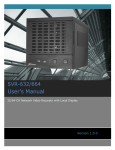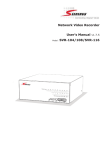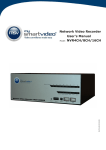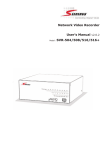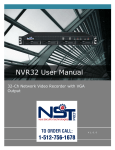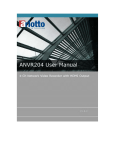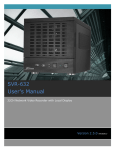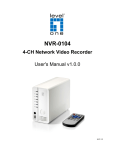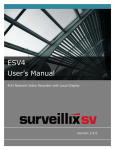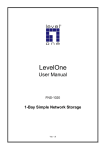Download SVR-632U User Manual
Transcript
NVR-0204/0208/0216 4/8/16-CH Network Video Recorder User's Manual v1.0.0 H/W: 2.0 2 NVR-02 Series User Manual Table of Contents Package Contents ..................................................................... 6 Product Description .................................................................. 7 System Overview...................................................................... 8 Front View ...................................................................................... 8 LED Definition ............................................................................... 9 Rear View (I/O Ports and RS-485) ............................................... 10 Installation............................................................................. 11 HDD Installation ........................................................................... 11 Connect to the NVR ...................................................................... 15 Use LevelOne Device Search Utility ................................................. 15 Access the NVR with its default IP address ....................................... 19 Set up Password .......................................................................... 21 Live View ................................................................................ 22 Retrieve camera’s video stream...................................................... 23 Retrieve camera’s status ............................................................... 23 Perform Sequence Viewing ............................................................ 24 PTZ Control ................................................................................. 25 Perform PTZ Preset Viewing ........................................................... 26 Preset Point Viewing ..................................................................... 26 Auto Pan Viewing ......................................................................... 27 Preset Point Sequence Viewing ....................................................... 27 Live Video Controls Buttons ........................................................... 28 Take a snapshot of a live video ...................................................... 29 Full Screen View of a Live Video ..................................................... 30 Turn On/Off Audio of a Live Video ................................................... 30 Start/Stop Recording of a Live Video ............................................... 30 Audio post ................................................................................... 30 Change Web UI Display Language .................................................. 30 Live View through iPhone Safari Browser ......................................... 31 Live View through Blackberry Phones .............................................. 34 Playback ................................................................................. 38 Methods to Search Playback Videos ................................................ 38 Search by time chart .................................................................... 39 Search by event ........................................................................... 41 Play by specific time ..................................................................... 42 Search by event (Most Recent) ...................................................... 43 Export Playback Videos to AVI Files................................................. 44 Play Exported Playback Videos with NVR Media Player ....................... 47 Open Event Snapshot images with NVR Media Player ......................... 48 System Setup ......................................................................... 49 System Configurations ................................................................. 49 Network Settings ......................................................................... 49 DHCP Server ............................................................................... 51 NVR-02 Series User Manual 3 DDNS Service .............................................................................. 52 Time and Date .............................................................................. 53 User Account ................................................................................ 54 Changing the password of the “root” account ................................... 55 Add a new user ............................................................................ 56 Group Privilege ............................................................................. 57 Disk Setup .................................................................................... 59 Channel Configurations .......................................................... 60 Add a camera ............................................................................... 60 Automatic Search ......................................................................... 60 Add a camera manually ................................................................. 63 OSD Settings ................................................................................ 64 PTZ Setting ................................................................................... 66 PTZ Preset Settings ...................................................................... 66 PTZ Preset Sequence .................................................................... 68 E-Map Setting ............................................................................... 69 Local Map Setting ......................................................................... 69 Google Map Setting ...................................................................... 71 Event Configurations .............................................................. 73 Event Configuration ...................................................................... 73 General Settings .......................................................................... 73 I/O Settings ................................................................................. 75 Event Servers ............................................................................... 76 Configuring an FTP server.............................................................. 76 Configuring an SMTP server ........................................................... 77 Event Triggers .............................................................................. 78 Recording Configurations ....................................................... 80 General Settings ........................................................................... 80 Schedule Recording ...................................................................... 84 To configure a schedule recording ................................................... 84 System Options ...................................................................... 86 Device Information ....................................................................... 86 Logs and Reports .......................................................................... 87 Maintenance ................................................................................. 88 Reboot the NVR at a specific time automatically................................ 89 Firmware Upgrade ........................................................................ 89 Through the web interface ............................................................. 89 Upgrade through USB thumb drive ................................................. 91 Reset the NVR to Factory Default .................................................... 92 DO Status ..................................................................................... 93 Disk Status ................................................................................... 93 USB Backup .................................................................................. 94 Things to pay attention to the USB Backup function .......................... 96 Play the backup file with the NVR Media Player ................................. 97 UPS Configuration ...................................................................... 100 4 NVR-02 Series User Manual Copyrights & Trademarks Trademarks LevelOne NVR-0204, NVR-0208, NVR-2016 Network Video Recorder (NVR) are registered trademarks of Digital Data Communications GmBH. Microsoft and Windows are registered trademarks of Microsoft Corporation. All other trademarks mentioned in this document are trademarks of their respective owners. Disclaimer This document is intended for general information purposes only, and due care has been taken in its preparation. Any risk arising from the use of this information rests with the recipient, and nothing herein should be construed as constituting any kind of warranty. The manufacturer reserves the right to make adjustments without prior notification. All names of people and organizations used in this documents examples are fictitious. Any resemblance to any actual organization or person, living or dead, is purely coincidental and unintended. NVR-02 Series User Manual 5 System Requirements The following are minimum system requirements for the system to operate the Network Video Recorder: Operating System Microsoft® Windows® XP Professional SP2, Windows Vista, Windows 7, Windows® 2003 Server, or Windows® 2008 Server Browser Microsoft Internet Explorer 7 or above CPU Minimum Intel® Pentium® 4 2.4 GHz or higher (Dual Core is recommended) RAM Minimum 1 GB of RAM, 2GB or above is recommended Network Minimum 10/100 Ethernet (Gigabit Ethernet is recommended) Graphics Adapter AGP or PCI-Express, minimum 1024× 768, 16 bit colors. (We highly recommend to work above the 1024 x 768 resolution to get the full experience of the software) Make sure your display DPI setting is set to default at 96DPI To set DPI value, right-click on desktop, choose “Settings” tab >> “Advanced” >> “General” 6 NVR-02 Series User Manual Package Contents Network Video Recorder RJ-45 Ethernet LAN cable Power cord Quick Installation Guide CD Manual/Utility Default Settings IP Address Username Password DHCP address root root If the NVR detects no DHCP server on the LAN environment, then the NVR’s IP will be static IP [192.168.101.50] NVR-02 Series User Manual 7 Product Description The Network Video Recorder is designed for use within a surveillance system, and performs recordings and playbacks pictures from network cameras in the system. It is a recording device using a hard disk drive to record camera pictures instead of using video tapes so that pictures recorded by repeated overwriting will not experience deterioration of the recorded picture quality. Up to 4 or 8 or 16 cameras can be connected via a network and it is possible to record their camera pictures. It is possible to perform the settings or operate the NVR using a web browser installed on a PC connected to a network. Recorded video can be played back from remote site by a PC. Up to 4 PCs (web browsers) can access this unit concurrently and it is possible to perform the settings and operate this unit. The NVR is compatible with most major brand cameras and its ability to automatically search and find available cameras on the network can greatly reduce the user effort when expanding the system. 8 NVR-02 Series User Manual System Overview Front View Network LED Status LED Channel LED Power LED HDD1 LED HDD2 LED Alarm LED Reset Button Buzzer Stop USB Port Button Power Button NVR-02 Series User Manual 9 LED Definition Green HDD Red Amber Network Status Power Alarm Amber Green Amber Green Red Green Red Amber Red None Green Camera LED Amber Amber Red Solid green when the hard disk is mounted and being accessed. Solid red for disk fail. Solid amber when recording is in process. Blinking when recycling. Solid amber for activity on a 1G bps network. Solid green for activity on a 10/100 Mbps network. Blinking during firmware upgrade. Shows solid green for normal operation. Blinking green when firmware upgrade is done. Flashes red for failed firmware upgrade. Normal operation. System off (power adapter remains plugged in). Blinking amber indicating device is initializing. Blinking when an alarm occurs. When alarm is reset. Solid green, live connected with no event or recording activity. Blinking amber, manual or event recording is being performed. Solid amber, schedule or continuous recording is being performed. Recording is set but no video from camera. 10 NVR-02 Series User Manual Rear View (I/O Ports and RS-485) Ethernet RS-232 GP I/O Power Connector Pin Signal 1 12V DC 2 GND 3~10 Alarm Input 11 Out1 12 Out2 13 Out3 14 Out4 15 RS485+ 16 RS485- NVR-02 Series User Manual Installation HDD Installation Start by removing the screws on the side: Push the top housing forward. Then lift it up. 11 12 NVR-02 Series User Manual The NVR supports SATA I or SATA II hard disks. The NVR supports max. 3TB per hard disk and it supports total of 2 hard disks (6TB). There is a cable connected between the from the LED board and the main board. You can remove it from the main board or simply put the top housing on the side like shown below. NVR-02 Series User Manual 13 Next, slide the hard drive into the tray. Make sure the SATA connectors are correctly aligned with each other. 14 NVR-02 Series User Manual Secure the hard drive with the tool-less screw provided in the box. Place the top housing back and secure it with the bottom housing. NVR-02 Series User Manual 15 Connect to the NVR There are various ways you can connect to the NVR and below are the suggested methods for different network setup: The NVR is placed in a network with a DHCP server: Connect to the NVR by using LevelOne Device Search Utility The NVR is placed in a network without DHCP server (or you are connecting to it directly): Access the NVR with its default IP Use LevelOne Device Search Utility If the NVR is placed in a corporate network or a local area network where a DHCP server is already presented, run the “LevelOne Device Search” utility from a computer that is on the same network and locate the NVR with its IP address that is assigned by the top-level DHCP server. 16 NVR-02 Series User Manual To begin, launch the “LevelOne Device Search” utility from the CD and proceed with the installation: Once the installation is complete, check the “Launch the program” option and click “Finish”. NVR-02 Series User Manual The search should start automatically and its status should be displayed. The NVR should be located and its IP address should be displayed: Double-click on it and the program should automatically access the NVR’s web administration page from your default browser. You may change NVR’s IP address by click on the button highlighted below. 17 18 NVR-02 Series User Manual You will be prompted for the NVR’s login information before proceeding to change device’s IP address. You may click on the button highlighted below to perform search again. Or double-click on any of the search results to access NVR’s web administration page. access NVR's web administration page perform search again NVR-02 Series User Manual 19 You should be prompted for the NVR’s username and password. Enter its default username “root” and password “root” and then click "OK" to enter the system Access the NVR with its default IP address The NVR comes with a pre-configured static IP “192.168.101.50”. However, it is only used when there is no DHCP server presented in the network. The NVR will turn on its DHCP server function and act as the DHCP server in the network. To connect to the NVR, use a PC that is on the same network over a switch or hub, or connect the PC directly to the NVR using a crossover CAT5 Ethernet cable. 20 NVR-02 Series User Manual The PC that is connected directly to the NVR (or within the same local area network) should receive an IP from the NVR. Simply access the NVR from your web browser with its IP address Again, you should be prompted for the username and password. Enter its default username “root” and password “root” and then click ”OK” to enter the system NVR-02 Series User Manual 21 Set up Password The default login username and password is root/root. To change the password of the root account, go to “Setup” --> “System Configurations” --> “User Account”, click on the “root” account in the account list then press the “edit” button to change its password. Finally, click “Apply” to save the change. 22 NVR-02 Series User Manual Live View Camera List Live Video Live Video Control Buttons PTZ Control The • • • • • • • • • • • “Live View” page provides the following functions: Retrieve camera’s video stream Retrieve camera’s status Perform Live Sequence Viewing PTZ Control Perform PTZ Preset Sequence viewing Perform manual recording Take snapshot Receive audio of a video stream Send audio Control “Buzzer” Change web UI display language If you are using Windows Vista or Windows 7, please make sure you open Internet Explorer with the “Administrator” privilege or log in to Windows with “Administrator” account. Right-click Internet Explorer NVR-02 Series User Manual 23 Retrieve camera’s video stream The camera list is expanded and displayed on the Live View page: • Click “All” to display videos in the 8-video mode or 16-video mode. • Click on a “Group” (ex. Group 1) to display videos from cameras under that group in quad view • Click on any camera to display video in single-view mode Retrieve camera’s status The camera list can show each camera’s current status. Each status is represented with different colors: Camera is connected Camera is NOT connected This channel has event triggered and is recording event Camera is current recording (manual/continuous/schedule) This channel has NOT been configured with any camera 24 NVR-02 Series User Manual Perform Sequence Viewing Sequence view is a function that allows you to view multiple video streams from certain cameras in sequence automatically without having to select them one by one. To perform sequence view, select “SEQ View” from the upper-left hand corner Next, select one or more camera(s) or camera group(s) for sequence viewing Then, select dwell interval from the drop-down menu and click "Start" to begin Click “All Channels” to quickly select all available channels and start sequence view in single-view mode. Click “All Groups” to quick select all available groups and start sequence view in quad-view mode Or simply select the desired channels and press “Start” to start sequence view The “All Group” button is not available in 4Ch NVR as it only has one group NVR-02 Series User Manual 25 PTZ Control PTZ control provides functions to pan, tilt, and zoom a PTZ camera as well as the ability to adjust camera focus and iris. Camera(s) that are currently being selected for live viewing will be listed in the PTZ drop-down menu. Simply select a camera then use the PTZ control panel to control the camera. Only PTZ capable cameras will be listed in the drop-down menu. The bar shown below allows you to control the pan/tilt speed. Larger number means bigger movement angle. 26 NVR-02 Series User Manual Perform PTZ Preset Viewing There are three functions provided in the “Preset” section: • Perform preset point viewing of a particular camera • Auto pan a particular camera • Perform preset point sequence viewing (In order to use this function, one must configure camera's preset points in "NVR Setup" >> "Channel Configurations" >> "PTZ Preset" first) Preset Point Viewing Start by selecting a PTZ camera from the drop-down list. Its available PTZ preset points will be listed in the dropdown list shown below: Select a preset position from the drop-down list and click "Go to" to move the live view to that position. NVR-02 Series User Manual 27 Auto Pan Viewing Start by selecting a PTZ camera from the drop-down list: Use the Auto Pan control buttons to pan right, left and stop auto pan * Certain cameras do not support bi-directional pan movements. Use the “Auto pan” button for such cameras Preset Point Sequence Viewing This function allows you to view multiple preset points from a video of a camera without having to select them one by one. Once you have defined the preferred preset points in “Channel Configurations” >> “PTZ Setting” >> “PTZ Sequence” under the “Setup” menu, click “Start” in the lower-left hand corner in Live View under “Preset” and the recorder will begin to display videos from those preset points in sequence automatically until you click “Stop”. In the Setup menu In the Live view 28 NVR-02 Series User Manual Live Video Controls Buttons Each live video window comes with control buttons with functions described below: Take a snapshot of a live video Turn on/off audio of a live video Start/stop recording of a live video (manual recording) Audio post function Full screen view of a live video Keep aspect ratio and true size Keep aspect ratio NVR-02 Series User Manual 29 Take a snapshot of a live video To take a snapshot of a live video, click the button and the snapshot of the video will be displayed in a pop up window. * If you are running Windows Vista or 7, please make sure IE is executed with the “Administrator” privilege in order for this function to work properly. Right-click anywhere on the image and select “Save Image as” from the pull-down menu In the pop up dialog, name the image file and choose which directory the image will be saved to and click “Save” 30 NVR-02 Series User Manual Full Screen View of a Live Video To view a video in full screen, click the button. To exit full screen video, double-click anywhere on the video. Turn On/Off Audio of a Live Video You can retrieve audio from a particular camera. Simply click the button to do so. The button will show in different color once the audio is turned on. Click on it again to turn off audio. Start/Stop Recording of a Live Video You can manually start or stop recording of a live video by using the button. The button will show in different color once the recording is started manually. Click on it again to stop recording. Audio post This function allows user to speak from a PC through a microphone and the audio can be played at the camera side if it has a speaker connected to it. Change Web UI Display Language You can change the web UI display language from the current login username link located at the upper-right hand corner. Click on the link opens up a new window which displays detail information about the user as well as a drop-down menu which lets you change the display language. NVR-02 Series User Manual 31 Live View through iPhone Safari Browser You can use iPhone and perform single channel live view to the NVR by using its Safari browser. To be able to view the live video through the Safari browser, make sure “javascript” is on under “Settings” >> “Safari” >> “Javascript” Once Javascript is enabled, click the “Home” button on the iPhone to go back to the home screen and open the Safari browser 32 NVR-02 Series User Manual Type in the IP address of the NVR in the address bar You should be prompted to enter the username and password to access the NVR NVR-02 Series User Manual Upon successful login, you should see the live view video of the first channel Click on the “Channel” drop-down menu to select other cameras 33 34 NVR-02 Series User Manual If a PTZ camera is selected, the corresponding control buttons will display (control PT only) * Please note that this function is camera dependent and is not available to all cameras. Certain cameras do not allow adjusting image size and the se- lection “Auto” will be used. Live View through Blackberry Phones You can use Blackberry and perform single channel live view to the NVR by using its Safari browser. To be able to view the live video through its browser, make sure “javascript” is enabled under “Browser” >> “Menu button” >> “Options” >> “Browser Configuration” NVR-02 Series User Manual 35 Enable the “Support Javascript” option and click the menu button and click “Save Options” Go to “General Properties Make sure two options illustrated above are enabled 36 NVR-02 Series User Manual Press the menu button and click the “Save Options” to save settings Press the button highlighted above to go back to the browser NVR-02 Series User Manual Type in the IP address of the NVR in the address bar You should be prompted to enter its username and password for access 37 38 NVR-02 Series User Manual Playback Methods to search playback Channels to be played back Playback Video Playback video control buttons Playback is a function that allows you to play one or more videos that were previously recorded by a chosen recording method or due to an event trigger. The NVR offers synchronized playback from up to 4 channels and various types of search methods are provided to help you find the footage you need quickly. You can turn on or off the audio of a recorded video at your choice if audio was also recorded during the recording of the video. Playback video can be viewed in full screen and snapshots can be taken and saved during a video playback. Methods to Search Playback Videos The NVR offers three methods to quickly help users find videos that were previously recorded: • Search by time: Specify a time range and search videos recorded within that range • Search by event: Find videos that were recorded due to event triggers • Play by start time: Enter a specific time a video was recorded to start playing back the video NVR-02 Series User Manual 39 Search by time chart Start by selecting which channel(s) you would like to perform a search on: Selected channels will be marked in red: Select “Search by time chart” from the “Search Method” dropdown list and click “Go” to start the search: 40 NVR-02 Series User Manual Results will then be displayed in a “Date/Channel” table and boxes marked in color represent videos found in those dates: Click on any colored cell box should direct you to the hour/channel table if there were multiple videos recorded during that date: NVR-02 Series User Manual 41 Search by event Start by selecting which channel(s) you would like to perform a search on: Selected channels will be marked in red: Select “Search by event” from the “Search Method” drop-down list and click “Go” to start the search. Results will then be listed like what is shown below (displays the oldest record top down). Click on a particular result to start the playback: 42 NVR-02 Series User Manual You may also specify a new start time to search and display results from then on. You can restrict the number of results to be displayed at once (max. 30) and perform the search again Play by specific time If you know when a recording was taken place, you may choose the “Play by start time” from the “Search Method” drop-down list Then you will be prompted to enter a specific time and date for the recorded video. NVR-02 Series User Manual Use the button to select month, date, and year Search by event (Most Recent) This function quickly displays the most recent event recordings from the selected channels, displaying the most recent result top down. You may click “Update” to update the list to display the most recent result. 43 44 NVR-02 Series User Manual Export Playback Videos to AVI Files User can export the recorded playback videos stored on the NVR to a local computer and save them in AVI file format. The files can then be played on the PC by a 3rd party media player such as VLC player or Windows Media player. Once you locate the recorded videos with steps described in the previous section, hit the “Export AVI” button on a video window of the video you wish to export. * If you are running Windows Vista or 7, please make sure IE is executed with the “Administrator” privilege in order for this function to work properly. A new dialog will pop up and allows you to speficy the time frame (or length) of the video you wish to export: NVR-02 Series User Manual 45 Click the button to pull down the calendar to help you specify the month, date and the year Specify the starting and ending hours of the video by entering numbers in the text boxes Hit the “Start” button to start exporting. The file will be automatically named and saved under the C:\ partition 46 NVR-02 Series User Manual You will be notified once the process is completed successfully The exported AVI file will be saved under the C partition * ffdshow is required in order to play the exported AVI file with Windows Media Player. NVR-02 Series User Manual 47 Play Exported Playback Videos with NVR Media Player You can also use the NVR Media Player to play the exported AVI files. This can save you the trouble of installing third-party media player or codecs when playing the exported AVI videos. The NVR Media Player will be automatically installed after the CMS software is installed. You can launch the player under “Start” >> “All Programs” >> “LevelOne” >> “NVR Management Software"” >> “NVR Media Player”. Click “Open” >> “AVI File” Locate the exported AVI file, and click “open”. (normally under “C:\ExportFolder)” The video will then start playing 48 NVR-02 Series User Manual Open Event Snapshot images with NVR Media Player The NVR sends snapshots that are taken when an event occurs to a destined FTP server or mail recepient. These type of snapshot images are saved in a proprietary image file format, h4i or p4i, and can only be opened by the NVR media player. To do so, Select “Open” from the top menu then select “Image File”. A new dialog should be displayed which lets you locate the image file. NVR-02 Series User Manual 49 System Setup System Configurations The “System Configurations” page provides users options to setup the device quickly and properly. After properly configuring all settings in all the sub-pages, users should expect a fully working network video recorder that is ready to manage cameras on the network. We will start by configuring its network settings to make sure it works correctly in your network. Next, we will help you adjust the system time so videos will be recorder with correct timestamp. To better secure the system for unwanted disturbance, we will guide you on setting up user’s account and privileges to prevent settings gets altered by users other than the system administrator. Lastly, we will tell you what you should expect after installing a hard disk and how to prepare the hard disk for the video recording. Network Settings You need to adjust settings in this page for the device to work properly in your network. It is critical that settings here are configured correctly based on your network configurations so that the recorder can be administered through the local area network and cameras can be connected from it. By default, the recorder is set to "Auto Mode" which if there's a DHCP server in the same local network, the NVR can obtain IP address from DHCP server, and you can locate the NVR by using the LevelOne Device Search utility. 50 NVR-02 Series User Manual If there's no DHCP server in the network, and the NVR is set to use "Auto Mode", it will use its own default static IP 192.168.101.50. The NVR supports three connection types that can be configured depends on how the network is setup. If you wish to set the recorder to use a static IP address in your local area network: 1. Choose “Static IP” from the “Connection Type” drop-down menu 2. Enter the IP address, subnet mask, default gateway address and DNS server address for the recorder 3. Enable “DHCP Server” under “DHCP Server” if you wish to use the recorder as a DHCP server, or leave it disabled if there is already a DHCP server in the network 4. Click Apply for the settings to take effect * The recorder can detect the presence of a DHCP server upon startup. It sets itself to use static IP address if there is no DHCP server currently presented in the network. Its DHCP server function is also turned on at the same time to assign IP addresses to cameras that are later connected to the network or you can manually turn off the DHCP server function from "System Configurations">>"Network Setup">>"DHCP Server" if you wish to use a separate DHCP server NVR-02 Series User Manual 51 DHCP Server The built-in DHCP Server function is NOT always configurable and is greatly dependant to the connection type that is set to use in "Device Network Setting": 1. If the connection type is "Auto Mode", the DHCP server function is NOT configurable. It will be ON if the NVR doesn't obtain an IP from a DHCP server in the local network and uses its own default static IP 192.168.101.50 2. If the connection type is "Auto Mode", the DHCP server function is NOT configurable. It will be OFF if the NVR obtains an IP from a DHCP server in the local network. 3. If the connection type is "DHCP Client", the DHCP server function is NOT configurable. It will be OFF if the NVR obtains an IP from a DHCP server in the local network. 4. If the connection type is "DHCP Client", the DHCP server function is NOT configurable. It will be ON if the NVR doesn't obtain an IP from a DHCP server in the local network and uses its own default static IP 192.168.101.50 5. If the connection type if "Static IP", the DHCP server function is configurable and can be turn on/off manually. 52 NVR-02 Series User Manual DDNS Service DDNS, which stands for “Dynamic DNS”, is a method, protocol, or network service that provides the capability for a networked device, such as a router or computer system (in this case, the NVR) using the Internet Protocol Suite, to notify a domain name server to change, in real time, the active DNS configuration of its configured hostnames, addresses or other information stored in DNS. A popular application of dynamic DNS is to provide a residential user’s Internet gateway that has a variable, often changing, IP address with a well known hostname resolvable through standard DNS queries. This is useful if the NVR is placed on the Internet with a dynamic public IP, which once the DDNS is properly setup, users can access the NVR remotely with the DDNS domain name without worrying if the IP has changed or not. *Please make sure a valid DNS server has been configured under the “Network Setting” page in order for this function to work properly. *The NVR currently only works with free DDNS service provided by “DynDNS”. For more information, please go to www.dyndns.com *If the NVR is placed behind a router or Internet gateway, please make sure port forwarding for port 80 is configured on the router or the gat- way in order for the DDNS function to properly register with the service. It’s often suggested to use the DDNS function in the router/ gateway for such case instead. *Once you have the DDNS function successfully up and running, please DO NOT forget to configure port forwarding for the NVR web port (default 80) and the streaming port (default 9877) in the router/gateway for remote viewing. You can then type in http://yourddnsdomain in the browser to access the NVR remotely for live view. NVR-02 Series User Manual 53 Time and Date Set the time and date by selecting the time zone according to your location. It is imperative that you set the recorder’s time correctly to avoid the following errors: • Incorrect display time for playback videos • Inconsistent display time of event logs and when they actually occur After selecting the time zone, choose an option below to set the recorder time • Manual – Use the drop-down list and configure the time manually • Sync with NTP server – enter the hostname or IP address of a valid NTP server and set how often the recorder should synchronize the time with it by using the “Update interval” drop-down menu • Sync with PC – Check this option to synchronize the recorder time with the PC that you are currently using to access the recorder 54 NVR-02 Series User Manual User Account Multiple users can access the recorder simultaneously. You can add, remove, and edit users by using options provided in this page to keep user information organized. Each recorder comes with a built-in “root” account with password “root”. It’s highly recommended to change the password upon your initial login. NVR-02 Series User Manual 55 Changing the password of the “root” account 1. 2. 1. Click and highlight the “root” account in the account list and click “Edit” 2. Its information should be displayed in “User Account Information” 3. Enter a new password in the “Password” field and enter it again in “Confirm Password” 56 NVR-02 Series User Manual Add a new user 1. Enter a username and password in “User Account Information”. All other fields are optional for your own reference. 2. Select a group from the “Group” drop-down menu to assign the new user to a particular group 3. Enter a short description for the account if you wish 4. Click “Add” to finish configuration NVR-02 Series User Manual 57 Group Privilege Group Privilege is where you can create multiple customized access policies for situations if you need the recorder to be accessed by users other than the administrator. You can do so by creating a group, and then remove access privileges for certain configuration pages or cameras. Users that are created and assigned to this group will have limited access instead of full administration rights. The recorder comes with seven built-in groups and five built-in privilege profiles, except the “root” and the “guest” accounts; the other five groups are fully customizable or you can simply assign a group with one of the default privilege profiles. You can, however, assign more than one users to the “root” account if you wish to do so. The guest account comes with a “view-only” privilege in the “Live View” page, and users in this group do not have the power to make any changes in the “Live View” page or have access to pages other than the “Live View” page. To create a group, select a group from the “Group” drop-down menu 58 NVR-02 Series User Manual You can change the group name by clicking the “Change Group Name” button. A text box will be displayed for you to enter the new group. Choose what type of privilege you would like this group to have from the “Privilege Type” drop-down menu. Its access privilege will then be displayed. You can alter its settings by allowing or denying access to other cameras using the checkboxes instead of accepting the defaults NVR-02 Series User Manual 59 Disk Setup Once you install a hard disk to the recorder, you would need to initialize it so that it can be ready for recording. You can obtain basic information about the disk you installed in this page. To initialize it, simply click the “Format” button. 60 NVR-02 Series User Manual Channel Configurations Add a camera The NVR provides two options for adding a new camera. Users have the option to let the recorder automatically find the cameras or it is possible to enter camera’s information and add it manually. Automatic Search Click the “Search” button to perform the camera search. You should be prompted to install Active Control component in order for the search to function properly. Go ahead and click “Install” NVR-02 Series User Manual 61 Once you have the ActiveX component installed, the search status should be displayed after clicking "Search" Found cameras should be listed and simply select a camera from the list and press “Configure” Its corresponding information should be displayed in the “Camera Information” section. Enter its username and password and select the channel ID and name the camera. 62 NVR-02 Series User Manual Click on “Detect” to establish connection between the recorder and the camera. If connection establishes successfully, camera’s detailed information should be polled and displayed as below. Adjust its video format, frame rate, resolution or bitrate...etc if you wish. You can also click on the “Preview” to preview the live video of the camera. Click “Add” to finish adding the camera *If cameras are marked with "*" in the search result, it means those cameras are already configured and connected to the NVR. NVR-02 Series User Manual 63 Add a camera manually Simply follow the instruction described above but instead of using the “Search” function, enter the camera’s IP address and credential in the “Camera Information” manually. 64 NVR-02 Series User Manual OSD Settings The OSD (On Screen Display) allows users to add informational text message and embed it onto the video. By default, this function is turned off. To add texts to one or more videos: Select a camera you would like to add text to and choose “Display OSD” Choose one or more display options if you would also like the recorder to automatically embed the system time or the frame rate for you. Or simply choose to display a custom message of your own. Next, define where the text will be displayed by either entering an X/Y value based on percentage or use the system pre-defined position from the drop-down menu. NVR-02 Series User Manual 65 Click on the “Preview” button to see the preview of your setting and click “Apply” to save the configuration. The texts can be further adjusted with changes to different size, color or font so they can be more visible on the video. 66 NVR-02 Series User Manual PTZ Setting PTZ Preset Settings The recorder supports PTZ cameras and can set multiple preset points or retrieve and manage preset points that are set in the camera. This is helpful if you need to monitor multiple spots in one area from a particular camera. NVR-02 Series User Manual 67 To set up PTZ preset points: 1. Select a camera from the “Camera” drop-down menu and click “Add”. 2. Select a position number for the preset point from the “Position Number” drop-down menu and fill in a name in the “Position Name” field for easier identification. 3. Use the PTZ control provided in the configuration page to set the preset point Ultimately, you can choose to make this preset point a “Home” point among all other preset points, as well as making the camera to move to this particular point when an event is triggered. * “Move Here when Event Trigger”: In order for this function to work properly, please also complete configuration in “Event Configuration” >> “Event Trigger” 68 NVR-02 Series User Manual PTZ Preset Sequence Once you have multiple preset points defined for a camera, it is convenient for monitoring to set up the sequencing viewing among those preset point and let the recorder automatically switch between them for you. To configure preset sequence for a camera, 1. Select a channel from the “Channel” drop-down menu. The available preset points should be listed in “Camera Presets” section. 2. Pick the ones you like for sequence viewing and press the “->” button to move them to the “Preset Sequence” section, then 3. use the up and down buttons to adjust their sequencing positions. 4. Finally, select a dwell time from the drop-down menu and click “Apply” to save the configuration NVR-02 Series User Manual 69 E-Map Setting Local Map Setting E-Map monitor is a function that alerts users whenever there is an event triggered (e.g. motion detected) from a camera with a geographical perspective. With this function, users can quickly identify which camera has detected an unusual event and where this event is happening. This function works by incorporating the event detection function as well as the recording function, which, as a result, helps users take all the necessary actions when an unusual event occurs. To replace the map, click “Browse” button to locate the new map image file from the local PC and then click “Upload”. * Only JPG, PNG, and GIF file formats are supported with file size under 100KB. 70 NVR-02 Series User Manual Then click and drag the camera icon to move the camera to define its location. Access the Local Map Monitor page from the upper-right hand corner menu. When the NVR receives an event triggered from any of the cameras, their videos will be displayed on the E-Map and you can double-click on the video to enlarge it. NVR-02 Series User Manual 71 Google Map Setting The Google Map monitor is a similar function to the aforementioned EMap monitor. It is useful if you are managing multiple cameras from different locations. To configure locations of each camera, first determine the location you’d like to place the camera to on the map. You can do so by: 1. Zoom in to a smaller area by using the zoom control bar on the map 2. Zoom in to a smaller area by using the mouse scroll button 72 NVR-02 Series User Manual You can also go to a specific place on the map by entering its address or the name of the place in the “Address or places of interest” field Once the location has been determined, click and drag the camera icon to move it to the desired location * The Google Map Monitor requires active Internet connection and cannot be used in conjunction with the regular Map monitor function. NVR-02 Series User Manual 73 Event Configurations Event Configuration The “Event Configurations” section allows users to define conditions that constitute an event, its corresponding trigger action and when it will be triggered. Such setting can reduce the management overhead and notify the administrator only when it’s necessary. General Settings The general settings section can help you quickly configure when an event is triggered, how often events are triggered and the corresponding actions when events are triggered. Start the event configuration by defining the general settings: Define when an event will be triggered • Choose “Always” or “Only during...” under “Event Trigger Duration” • For the “Only during...” option, choose the days by using the checkbox and then define the time range in those days in the “Start Time” and “End Time” fields that you would like the event trigger function to be enabled. 74 NVR-02 Series User Manual How often an event is triggered • Set a time interval under “Event Trigger Interval” to define how often events are triggered Trigger action Now that you have the event trigger duration and interval defined, choose what action to be taken during an event trigger: • You can choose to have the recorder send out the first few frames of the video recorder upon an event is triggered • You can also choose to have the recorder send out a warning message in e-mail or in txt file format and upload it to an destined FTP server NVR-02 Series User Manual 75 I/O Settings This function allows users to manage camera’s digital input and output ports right from the recorder. You can setup the recorder to receive triggers from a particular camera’s input port and trigger a device, such as an alarm that is connected to the recorder or camera’s output port. Cameras that do not have built-in digital input/output port can also be configured to pair with the recorder’s DI/DO ports. 1. For cameras that come with physical digital input ports, their ports will be listed in the far left drop-down menu. 2. Pick the desired channel for I/O mapping, and then select the camera’s input port from the drop-down menu. 3. Select the trigger condition from the “Condition” drop-down menu. 4. Select the recorder’s input port if you would also like to use the recorder’s input port for event trigger. And then select the trigger condition as well. 5. Next, select the recorder’s output port and define its trigger state 6. Finally, define the trigger duration. *The recorder does not control camera's input or output ports in a way to let you pair recorder itself with a camera's input or output port for event receiving or triggering. *The recorder only acts as a medium for pairing up input/output ports between cameras and the recorder. *Only connected cameras will be displayed in the list. *Some cameras only allow one trigger source be configured at a time, e.g. if the camera has the motion detection function turned on, its digital input will be disabled and vice versa. Under such circumstance, if you set to use camera’s digital input port as the event trigger source, you will not be able to select motion detection as the trigger source for this camera under “Event Configurations” >> “Event Trigger” setup page. * The image(s) that are uploaded to the destined FTP server or emailed to a destined mail recipient are in their own proprietary image file format (.h4i or .p4i), which can only be opened by the NVR media player. 76 NVR-02 Series User Manual Event Servers Event servers are to be used with event trigger actions. In case of unusual motion detected by the camera or a disk failure, the recorder can send notification with the acceptable format (image/txt) to a destined event server according to the configuration. Configuring an FTP server To add an FTP server, 1. Start by giving a name to the server that you are adding to the recorder 2. Enter the hostname or the IP address of the FTP server 3. Enter the communication port of the FTP server (usually port 21) 4. Enter the username and password of the FTP server if it’s required 5. Check “Use Passive Mode” if it’s required or leave it unchecked to use active mode 6. Click “Test” to verify if all information is entered correctly and the connection to the FTP server can be established successfully 7. Click “Add” for the settings to take effect NVR-02 Series User Manual 77 Configuring an SMTP server 1. Enter the hostname or the IP address of the SMTP server 2. Enter the port of the SMTP server 3. Specify the sender’s name in the “Sender’s name” field 4. Enter the sender’s e-mail address 5. Check “Enable Authentication” and enter the username and password of the SMTP server if it requires authentication 6. Click “Apply” to save the configuration *The NVR supports SMTP servers that use base64 or MD5 authentication methods. * 3rd party free E-mail services such as Gmail, Hotmail, or Yahoo mail are not supported. 78 NVR-02 Series User Manual Event Triggers We have finished defining how an event will be triggered and which servers will be receiving notifications in the previous two sections, now we can finish up the event configuration by setting: • Which channels will have event trigger function enabled • What is considered to be an event • Where the warnings will be sent to and how they will be sent Use the checkbox to enable event trigger on the desired channels. *Once motion detection is enabled in this page, please configure the motion area and enable motion detection in the corresponding channels (cameras) from camera's own web UI. The NVR only detects the first motion area set in the camera. The NVR recognizes the first motion area by its ID number set in the camera. * Enabling the “custom event” option allows the NVR to receive events from the CMS software and start recording; events such as the intelligent video detection in the CMS. NVR-02 Series User Manual 79 Define which system events should trigger the recorder to send out notifications. Define how the notifications will be sent and where they will be sent to. * Event trigger may not work for cameras that are placed outside of your local network or on the Internet until the “UPnP Port Forwarding” is enabled in both the NVR and the router. 80 NVR-02 Series User Manual Recording Configurations The “recording configurations” gives users the overall control of how and when a recording is performed and the quality of different types of recordings performed on each channels. It can help the recorder to operate with sufficient system resource by performing recording only when it’s necessary with adjustable recording frame rate. General Settings You can define the following in “General Settings”: • • • • • • Pre-Alarm/Post-Alarm recording length Recording frame rate Turn on/off HDD recycle function Define to always keep a number of days of previously recorded data Enable/disable different recording types on different cameras Enable/disable audio recording The “recording buffer” allows user to define “pre-alarm” and “postalarm” time for event recordings. The “pre-alarm” time sets the NVR to record in advance when an event is triggered. The “post-alarm” NVR-02 Series User Manual 81 time sets the NVR to continue recording for a period of time after an event trigger is finished. * The “Pre-alarm” function only works when the “Continuous” recording is also activated. Recording frame rate allows you to set different frame rate for different types of recording instead of recording at one frame rate only. Use the drop-down menu and select one of the pre-defined frame rates for a particular recording type You are able to use the same video format for recordings or you can choose other formats for different recording purposes if it's a multistream capable camera. If you chose to use a different video format for recording, you are able to adjust its detail settings by clicking on the "...". A new dialog will pop out for further detail configurations. Noticing the "Frame rate" in this dialog represents the live fps that will be set back to the camera for this particular video format. You can configure the recording fps for different types of recordings individually. 82 NVR-02 Series User Manual The HDD space recycle function is turned on by default. You can alternatively turn it off and set a system event in "NVR Setup">>"Event Configurations">>"Event Trigger">>"Event Handling Settings">>"When NVR is triggered by", and set a desired disk remaining space for event trigger condition. You'd have to take action manually after you get the system event notification, such as replacing disk, turn on HDD recycle function, or backup recording data. Users can also set to keep a previous number of days of recording data by enabling the option below. This is quite often used in application such as banking which certain countries requires to always keep a minimum previous number of days of recording data. * If this option is enabled, once the hard drive is full, the recycle function will then start but it will ensure that the number of days of recording data defined here will stay in hard drive instead of wiping out 20GB of data at a time. * If the hard drive is not full, the NVR re-calculates twice a day (each at 2:30am and 2:30pm) to keep the defined number of days of recording data from these two particular point of time backward. NVR-02 Series User Manual The section at the bottom of the page allows you to disable audio recording (record video only) of particular channels. 83 84 NVR-02 Series User Manual Schedule Recording You can define the time range of the schedule recording for all channels in this page. To configure a schedule recording Use the “Channel” drop-down menu and select a camera first. You can use the schedule table to set the time range. Click the cell boxes then move horizontally lets you set what hours to perform recording during a day. Click and move vertically lets you set what days to perform recording at a specific time. NVR-02 Series User Manual 85 * Each cell box represents 15 minutes of time. Click one or more boxes to omit consecutive recording. You can also use the “Quick Configuration” to define recording time range instead of clicking cell boxes one by one on the time table. Simply check what days you would like to perform recording and specify the recording duration by either choosing “All Day” or enter a start and end time for specific recording duration. Select the “Copy to” option if you would like to set the same recording schedule to another camera. 86 NVR-02 Series User Manual System Options System Options gives users a glance of the overall system status and allows users to perform maintenance tasks such as upgrading firmware, restore/backup device settings or reboot device ....etc. Device Information The “Device Information” provides the general information of the device such as firmware version and system time. It also provides information of the current network settings and status. NVR-02 Series User Manual Logs and Reports “Logs and Reports” keeps a record of what’s been happening to the device and provides basic information for troubleshooting. 87 88 NVR-02 Series User Manual Maintenance “Maintenance” provides functions for users to: • • • • • • Reboot the NVR when necessary Reboot cameras directly from the NVR Perform Firmware Upgrade Backup the NVR’s settings to a local hard drive Restore the NVR’s settings from a previously saved configuration file Reset the NVR’s settings to their factory default values NVR-02 Series User Manual 89 Reboot the NVR at a specific time automatically You can configure the NVR to restart automatically by using the options given in the web UI. You can set the NVR to restart at a particular hour of a specific day during a week or a month. Firmware Upgrade The firmware can be upgraded through web UI or USB. Before upgrading firmware, please backup configuration in advance. ** the firmware file comes with a “.tar.gz” file extension, please use the file as is, DO NOT unzip it. It’s normal that you may only see “.tar” as the the “.gz” file extension is hidden by default in Windows. You will get “incorrect file format” error message if the file extension is altered. Certain personal firewall may also cause such problem. Through the web interface Login into NVR’s web management UI. Go to "Setup" page and go to "System Options"->"Maintenance" 90 NVR-02 Series User Manual On "Upgrade NVR's Firmware" section, click "Browse" and select new firmware file A new dialog should display and let you choose the location of the firmware file. When done, click “Upgrade”. NVR-02 Series User Manual 91 Follow the on screen instruction and wait for the process to finish (After upgrade, the system will reboot automatically, it’s part of the process) Upgrade through USB thumb drive 1. Prepare a USB flash disk and format with FAT or FAT32 format 2. Place the firmware in the USB flash disk and make sure it’s placed at the top-level directory. Please do not place the file in a folder. (make sure to change the firmware file name to “firmware” and leave its file extension “.tar.gz” as is before placing the file to the USB disk) 3. Plug USB flash disk into USB port on the NVR 4. The System LED on the NVR will start to flash in amber. This indicates firmware upgrade is in process 5. *** Warning *** Please wait until upgrade process finished, interrupt the upgrade process may cause system not work anymore 6. Wait until System LED remains solid in amber. This indicates firmware upgrade is finished 7. Power off the NVR and remove the USB disk the power the unit back on again 8. Restore configuration file back if needed 92 NVR-02 Series User Manual Reset the NVR to Factory Default To reset the recorder back to its factory default, click “Restore Factory Default” button and begin the process. The process should be displayed and you should be prompted back to the “Live View” page after it is complete. NVR-02 Series User Manual 93 DO Status This is where you can get the current status of the NVR’s digital output ports. You can also change their status from this page. Disk Status “Disk Status” gives you a more detailed information of the hard drive that is currently installed in the NVR. 94 NVR-02 Series User Manual USB Backup It’s a function that allows users to backup the recording data in its database file format (not AVI) to the externally connected USB hard disk. You can check the “Disk Status” page under “System Options” to see if the USB disk has been detected by the NVR. If it's available, it will also be in the USB HDD drop-down menu in the USB backup page. * It needs a USB disk containing free space larger than 100MB. NVR-02 Series User Manual 95 Once it’s detected, go back to the “USB Backup” page and it should be available for further configuration The USB hard disk(s) will be listed in the drop-down menu displaying the remaining disk space. Make your selection from the drop-down menu if you have more than one disks connected to the NVR. 96 NVR-02 Series User Manual Next, select channels, which you would like to backup the recording data from. Maximum 4 channels can be selected at once Configure the start and end time of the recording data you would like to backup and click the “Backup” button to begin. Things to pay attention to the USB Backup function Limitation: • It does not support USB Hub extend the number of HDD connected to the NVR • Only one backup process can be performed at a time • Maximum 4 channels can be selected for backup • Only FAT32 USB hard disk is supported for backup • The USB hard disk needs to have more than 100MB remaining space • If multiple partitions are presented in one disk, only the first partition will be detected and used for backup Process: • Progress will be displayed on the UI • If the backup process gets interrupted, which the process stops at a point of time that is before the “END Time” user defined, such time will be displayed on the UI • A folder will be automatically created in the USB hard disk with a name format like 0028687831_20100610151515_2010060511 0010_20100606110010 (MAC_backupbuttonclicktime_starttime_ endtime) Note: • Please plug in the USB HDD only after the NVR is fully started, or the HDDs will be incorrectly mounted. NVR-02 Series User Manual 97 Play the backup file with the NVR Media Player The backup files can be played with the NVR media player. To do, open the player and select “Open” >> “Media Database” Click “Browse...” to select the file from the USB disk. 98 NVR-02 Series User Manual A new dialog should be prompted for you to select the file location. When done, click “Check” to validate the file. Once the file has been successfully verified, you should be prompted with the message shown below. Select the time zone according to your current location. NVR-02 Series User Manual Finally, click “OK” to begin playing. The player should now play the backed up file. 99 100 NVR-02 Series User Manual UPS Configuration Connect the UPS to the NVR’s USB port for sending and receiving signals between the UPS and the NVR. The NVR can receive signal from the UPS when there is a power failure and shut down itself automatically within a period of time. You can enable UPS support to prevent data loss when an unexpected power failure occurs. To enable local UPS support (NVR acting as UPS server): 1. Connect the compatible USB UPS to the NVR 2. Turn on the NVR 3. Go to “NVR Setup” >> “System Options” >> “UPS Configurations”, and check “Enable UPS Support” option. You can adjust how long the UPS stays on to provide backup electricity to the NVR after a power failure by choosing one of the options from the drop-down shown below: * Currently only APC Smart-UPS 750 is supported (05282012) NVR-02 Series User Manual 101 The UPS information should be obtained an displayed at the bottomof the page after the settings are applied: To enable network UPS support (NVR acting as UPS slave): 1. Go to “NVR Setup” >> “System Options” >> “UPS Configurations”, and check “Enable UPS Support” option. 2. Enter the IP address of the NVR running as UPS server. (The NVR with USB UPS physically attached to) * Please make sure both NVRs (UPS server and slave) are on the same local network to ensure the communication between the two. * Please make sure both NVRs are plugged into the outlets that connect to the UPS.





































































































